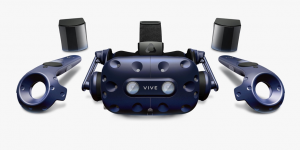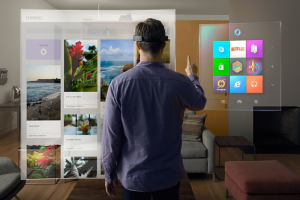VR Headsets – HTC Vive Pro (Preferred)

The HTC Vive Pro headset is one of the most advanced consumer VR headsets available today.
When it comes to VR, I feel that immersion is one of the key aspects to having a great user VR experience. One of the key specifications to achieving a more immersive experience in VR is the visual fidelity of the VR headsets. The HTC Vive Pro has a crisp 2880 x 1660 resolution that minimizes much of the screen door effect, one of the usual complaints of current VR headsets.
Besides the impressive technical specifications of the Vive Pro, HTC’s collaboration with Valve Corp means that the HTC Vive has access to many current, updated content from the Steam platform. This means that I am definitely not worried about finding VR content/games from the expansive Steam library that I am sure to enjoy.
One of Vive Pro’s other standout features is the room-scale technology that it offers, which allows the VR setup to track user movement within a room for a game. The Vive blog mentions that this increases the “state of presence” in VR and therefore improves on immersion within the VR content.
Rounding off, built-in headphones are also included in the HTC Vive Pro, which means we do not need to get external headphones for audio to match the visual content on the VR headsets.
Many technical reviews have also complimented on the well-rounded offerings by the HTC Vivo Pro, and it is regarded as one of the best VR headsets on the market today. When we are talking about the latest and greatest, the HTC Vive Pro is arguably hard to beat.
Other great VR headsets –
Oculus Rift, Oculus Go, The original HTC Vive
AR – Focals AR eyewear

I think smart glasses are a great future mainstream application of AR. Unfortunately, many of the smart glasses today have designs that make its users stand out too much from the crowd. I think one of the best ways for smart glasses to gain traction is to have a design that is not too unique, bulky and unwieldy as it is in many current smart glasses. Unlike the google glass, AR focals display AR content by using a “projector” to “beam content” into the user’s retina, hence the less bulky design as compared to displaying user content though an external screen (such as the Google Glass).
Intel’s Vaunt smart glasses would have been a top contender in this category too, since it does have a sleek design with many promised useful features. Unfortunately, Intel has ceased development of these glasses, so I feel that the Focals AR is one of the current smart glasses that I really like and would love to try wearing.
Mixed Reality (Preferred)
Microsoft HoloLens

While I have never tried using the HoloLens before, its features certainly sound very impressive, despite being announced a while back in 2017. The HoloLens provide a unique “Hologram” display where reviews have mentioned that it has an impressive resolution.
User control of this device is also said to be extremely easy and the handsfree experience is said to be a refreshing, futuristic change for most users. This is because, unlike many VR headsets that require users to carry a hardware controller for user input into the system, the HoloLens can simply register pure hand gestures as control inputs instead. Thus, this removes a need for users to even carry an additional controller, freeing up our hands for many other tasks.
In addition, the audio prowess of the device is said to be very competitive. Since the HoloLens is a device that allows the user to continue interacting with the real world, the speakers do not isolate ambient sound. However, it supports binaural audio that provides a spatial awareness of sounds emitted from the speaker.
Lastly, interacting with the device itself is extremely easy, due to the Holographic Processing Unit powering the device. Together with the CPU and GPU included in the HoloLens, the user experience on the HoloLens have been reviewed to be very fluid and very pleasant to navigate around.

I think the HoloLens still has the biggest potential for future user and content growth as a consumer mixed reality head set. Thus it is still my preferred headset, even if there are already other newer competing headsets in the market.
Perhaps, its only downside is the exorbitant asking price of USD $3000.
